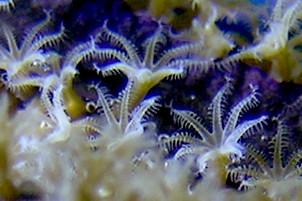|
Dinomischus
''Dinomischus ''is an extinct genus of stalked filter-feeding animals within the Cambrian period, with specimens known from the Burgess Shale and the Maotianshan Shales. While long of uncertain affinities, recent studies have suggested it to be a stem-group ctenophore. History of study In his pioneering excavations of the Burgess Shale, Charles Doolittle Walcott excavated the first, and at the time only, specimen. It had evidently caught his eye, for he had taken the trouble to carefully photograph it—but he never found the time to describe the organism, and it was not until 1977 that Simon Conway Morris described the animal. He tracked down two further specimens, collected by further expeditions by teams from Harvard and the Royal Ontario Museum, allowing him to produce a reconstruction. Description ''Dinomischus isolatus'' reached 20 mm in height, was attached to the sea floor by a stalk, and looked loosely like a flower. The cup-shaped body at the top of the stalk ... [...More Info...] [...Related Items...] OR: [Wikipedia] [Google] [Baidu] |
Entoproct
Entoprocta (), or Kamptozoa , is a phylum of mostly sessile aquatic animals, ranging from long. Mature individuals are goblet-shaped, on relatively long stalks. They have a "crown" of solid tentacles whose cilia generate water currents that draw food particles towards the mouth, and both the mouth and anus lie inside the "crown". The superficially similar Bryozoa (Ectoprocta) have the anus outside a "crown" of hollow tentacles. Most families of entoprocts are colonial, and all but 2 of the 150 species are marine. A few solitary species can move slowly. Some species eject unfertilized ova into the water, while others keep their ova in brood chambers until they hatch, and some of these species use placenta-like organs to nourish the developing eggs. After hatching, the larvae swim for a short time and then settle on a surface. There they metamorphose, and the larval gut rotates by up to 180°, so that the mouth and anus face upwards. Both colonial and solitary species also ... [...More Info...] [...Related Items...] OR: [Wikipedia] [Google] [Baidu] |
Daihua
''Daihua sanqiong'' is a possible ancestor of comb jellies. It was a sessile relative to comb jellies. It had combs with cilia just like modern day comb jellies. It is named after the Dai people. The name means Dai flower. In 2019, ''Daihua'' and other Cambrian forms were hypothesized to be stem-group ctenophores. This leads to the assertion that ctenophores evolved from immotile, suspensivorous forms, a lifestyle similar to that of polyps. Cladogram after Zhao ''et al.'', 2019: See also * '' Xianguangia'' * ''Dinomischus ''Dinomischus ''is an extinct genus of stalked filter-feeding animals within the Cambrian period, with specimens known from the Burgess Shale and the Maotianshan Shales. While long of uncertain affinities, recent studies have suggested it to be a ...'' * '' Siphusauctum'' References Prehistoric animals Cambrian genera Fossil taxa described in 2019 Animals described in 2019 {{Cambrian-animal-stub ... [...More Info...] [...Related Items...] OR: [Wikipedia] [Google] [Baidu] |
Siphusauctum
''Siphusauctum'' is an extinct genus of filter-feeding animals that lived during the Middle Cambrian about 510 million years ago. Description ''Siphusauctum'' was a sessile animal that was attached to the substrate by a holdfast. It had a tulip-shaped body, called the calyx, into which it actively pumped water that entered through pores and filtered out and digested organic contents. It grew to a length of only about . It is suggested to have primarily consumed microplankton. Taxonomy Species ''Siphusauctum gregarium'' was described in 2012 from numerous fossils recovered from the "Tulip Beds" strata of the Burgess Shale of Yoho National Park, British Columbia, Canada. The generic name comes Latin ' ("cup" or "goblet") and ' ("large"), referring to the general shape and size of the animal. The specific epithet comes from Latin ' ("flock" or "herd") referring to the large numbers of specimens recovered. This species is colloquially referred to as the “Tulip Animal” d ... [...More Info...] [...Related Items...] OR: [Wikipedia] [Google] [Baidu] |
Xianguangia
''Xianguangia'' is a soft-bodied sea anemone-like fossil animal from the Chengjiang Biota of China. Description ''Xianguangia sinica'' has a cylindrical body with a whorl of nearly 16 tentacles around the oral disc, similar to the modern anthozoans. The tentacles are feather-like with dense pinnules on both sides of the axis which would have been well adapted to filter feeding. A bowl-shaped attachment disc at the basal part might commonly have been buried in the sediment to allow its sedentary strategy on the sea floor. The body above the pedal disc is broad and cylindrical and may correspond to the internal gastrovascular cavity. It displays several distinct longitudinal grooves and ridges on the surface, indicating possible mesenteries. However, its phylogenetic affinity has long been questioned; it has even been alleged to be related to members of the Ediacara biota. Studies from the late 2010s onwards argued that it was likely to be member of the stem-group of Ctenophora (com ... [...More Info...] [...Related Items...] OR: [Wikipedia] [Google] [Baidu] |
Ctenophora
Ctenophora (; : ctenophore ) is a phylum of marine invertebrates, commonly known as comb jellies, that inhabit sea waters worldwide. They are notable for the groups of cilia they use for swimming (commonly referred to as "combs"), and they are the largest animals to swim with the help of cilia. Depending on the species, adult ctenophores range from a few millimeters to in size. 186 living species are recognised. Their bodies consist of a mass of jelly, with a layer two cells thick on the outside, and another lining the internal cavity. The phylum has a wide range of body forms, including the egg-shaped cydippids with a pair of retractable tentacles that capture prey, the flat, generally combless platyctenids, and the large-mouthed beroids, which prey on other ctenophores. Almost all ctenophores function as predators, taking prey ranging from microscopic larvae and rotifers to the adults of small crustaceans; the exceptions are juveniles of two species, which live a ... [...More Info...] [...Related Items...] OR: [Wikipedia] [Google] [Baidu] |
Ctenophore
Ctenophora (; : ctenophore ) is a phylum of marine invertebrates, commonly known as comb jellies, that inhabit sea waters worldwide. They are notable for the groups of cilia they use for swimming (commonly referred to as "combs"), and they are the largest animals to swim with the help of cilia. Depending on the species, adult ctenophores range from a few millimeters to in size. 186 living species are recognised. Their bodies consist of a mass of jelly, with a layer two cells thick on the outside, and another lining the internal cavity. The phylum has a wide range of body forms, including the egg-shaped cydippids with a pair of retractable tentacles that capture prey, the flat, generally combless platyctenids, and the large-mouthed beroids, which prey on other ctenophores. Almost all ctenophores function as predators, taking prey ranging from microscopic larvae and rotifers to the adults of small crustaceans; the exceptions are juveniles of two species, which live ... [...More Info...] [...Related Items...] OR: [Wikipedia] [Google] [Baidu] |
Siphusauctum Gregarium
''Siphusauctum'' is an extinct genus of filter-feeding animals that lived during the Middle Cambrian about 510 million years ago. Description ''Siphusauctum'' was a sessile animal that was attached to the substrate by a holdfast. It had a tulip-shaped body, called the calyx, into which it actively pumped water that entered through pores and filtered out and digested organic contents. It grew to a length of only about . It is suggested to have primarily consumed microplankton. Taxonomy Species ''Siphusauctum gregarium'' was described in 2012 from numerous fossils recovered from the "Tulip Beds" strata of the Burgess Shale of Yoho National Park, British Columbia, Canada. The generic name comes Latin ' ("cup" or "goblet") and ' ("large"), referring to the general shape and size of the animal. The specific epithet comes from Latin ' ("flock" or "herd") referring to the large numbers of specimens recovered. This species is colloquially referred to as the “Tulip Animal” d ... [...More Info...] [...Related Items...] OR: [Wikipedia] [Google] [Baidu] |
Phyllopod Bed
The Phyllopod bed, designated by USNM locality number 35k, is the most famous fossil-bearing member of the Burgess Shale fossil ''Lagerstätte''. It was quarried by Charles Walcott from 1911–1917 (and later named Walcott Quarry), and was the source of 95% of the fossils he collected during this time; tens of thousands of soft-bodied fossils representing over 150 genera have been recovered from the Phyllopod bed alone. Stratigraphy and location The phyllopod bed is a 2.31 m thick layer of the 7 m thick Greater Phyllopod Bed, found in the Walcott Quarry on Fossil Ridge, between Wapta Mountain and Mount Field, at an elevation of around , around north of the railway town of Field, British Columbia, in the Canadian Rocky Mountains. It is adjacent to Mount Burgess, where Walcott first discovered the Burgess Shale formation. Walcott divided the bed into twelve units based on the rock type and fossil content. Certain fossil beds provide reference levels and ca ... [...More Info...] [...Related Items...] OR: [Wikipedia] [Google] [Baidu] |
Polyp (zoology)
A polyp in zoology is one of two forms found in the phylum Cnidaria, the other being the medusa (biology), medusa. Polyps are roughly cylindrical in shape and elongated at the axis of the vase-shaped body. In solitary polyps, the aboral (opposite to oral) end is attached to the substrate (biology), substrate by means of a disc-like holdfast (biology), holdfast called a pedal disc, while in colony (biology), colonies of polyps it is connected to other polyps, either directly or indirectly. The oral end contains the mouth, and is surrounded by a circlet of tentacles. Classes In the class Anthozoa, comprising the sea anemones and corals, the individual is always a polyp; in the class Hydrozoa, however, the individual may be either a polyp or a medusa (biology), medusa, with most species undergoing a biological life cycle, life cycle with both a polyp stage and a medusa stage. In the class Scyphozoa, the medusa stage is dominant, and the polyp stage may or may not be present, depen ... [...More Info...] [...Related Items...] OR: [Wikipedia] [Google] [Baidu] |
Journal Of Paleontology
The ''Journal of Paleontology'' is a peer-reviewed scientific journal covering the field of paleontology. It is managed and published by Cambridge University Press on behalf of the Paleontological Society. Indexing The ''Journal of Paleontology'' is indexed in: *BIOSIS Previews *Science Citation Index *The Zoological Record *GeoRef __NOTOC__ The GeoRef database is a bibliographic database that indexes scientific literature in the geosciences, including geology. Coverage ranges from 1666 to the present for North American literature, and 1933 to the present for the rest of th ... References Paleontology journals Academic journals established in 1927 Academic journals published by learned and professional societies Cambridge University Press academic journals Bimonthly journals Paleontological Society {{paleo-journal-stub ... [...More Info...] [...Related Items...] OR: [Wikipedia] [Google] [Baidu] |
Geology Today
''Geology Today'' is a bimonthly peer-reviewed scientific journal published by Wiley on behalf of the Geologists' Association and the Geological Society of London. The editor-in-chief is Peter Doyle (Geological Society of London). The journal covers all aspects of the Earth sciences. Abstracting and indexing The journal is abstracted and indexed in Aquatic Sciences and Fisheries Abstracts, EBSCO databases, ProQuest databases, Scopus, and The Zoological Record ''The Zoological Record'' (''ZR'') is an electronic index of zoological literature that also serves as the unofficial register of scientific names in zoology. It was started as a print publication in 1864 by the Zoological Society of London, .... References External links * Geology journals Wiley (publisher) academic journals Geological Society of London academic journals Academic journals established in 1985 Geologists' Association 1985 establishments in the United Kingdom {{geology-journal-stub ... [...More Info...] [...Related Items...] OR: [Wikipedia] [Google] [Baidu] |




